|
Spend
enough time noodling on the fretboard and you start to notice
some things. What follows is, in my opinion, one of the
best approaches to understanding the neck as whole and that
is - making comparisons.
You
can teach yourself an awful lot about how the fretboard
works just by recreating something you know in a different
part of the neck either by sound or note value. You do-it-yourselfers
can appreciate that. And the idea isn't limited only to
scales, it applies to chords
as well.
Because
scales tend to involve more notes than chords and in fact
are the source for chords, I'll use the mother of all scales,
C major, to illustrate this concept. (And as a bonus, I'll
throw in a little chord stuff.)
First,
we'll start off with a very simple comparison.
Here's
C major running straight up the 5th string illustrating
the order of tones and semitones;

Now
here's the same scale localized on three strings. Notice
the visual representation of tones and semitones is different
but it sounds the same;
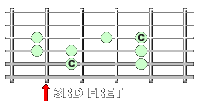
*
If it sounds the same, it must be the same! *
Have
a look at the scale covering all six strings starting from
the 6th string root. For the purpose of clarification, the
image on the left was left unaltered, while the image on
the right shows how the notes of a C major bar chord are
contained or "caged" within the pattern;
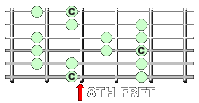  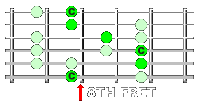
(Note;
Being able to envision a chord or scale, without your
fingers on it, is a very cool thing. More on that at a
later date.)
Now
for comparison, let's see what C major looks like
when it's built primarily behind the root fret;
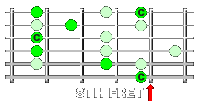
And
lastly, a form that works ahead of the root fret;
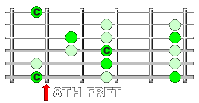
So
which one is the right or correct form? Well, the answer
is they all are. It's just a matter of preference. When
I was first discovering this information for myself, I would
see a scale form first printed one way, then another and
then another! This confused the heck out of me until I realized
it was simply a matter of the author's preference.
Which one you use is whichever one you like or does the
job. Given enough time, you'll wind up using them all and
these are just some of them. Now, how you use them
is a different story...
|

